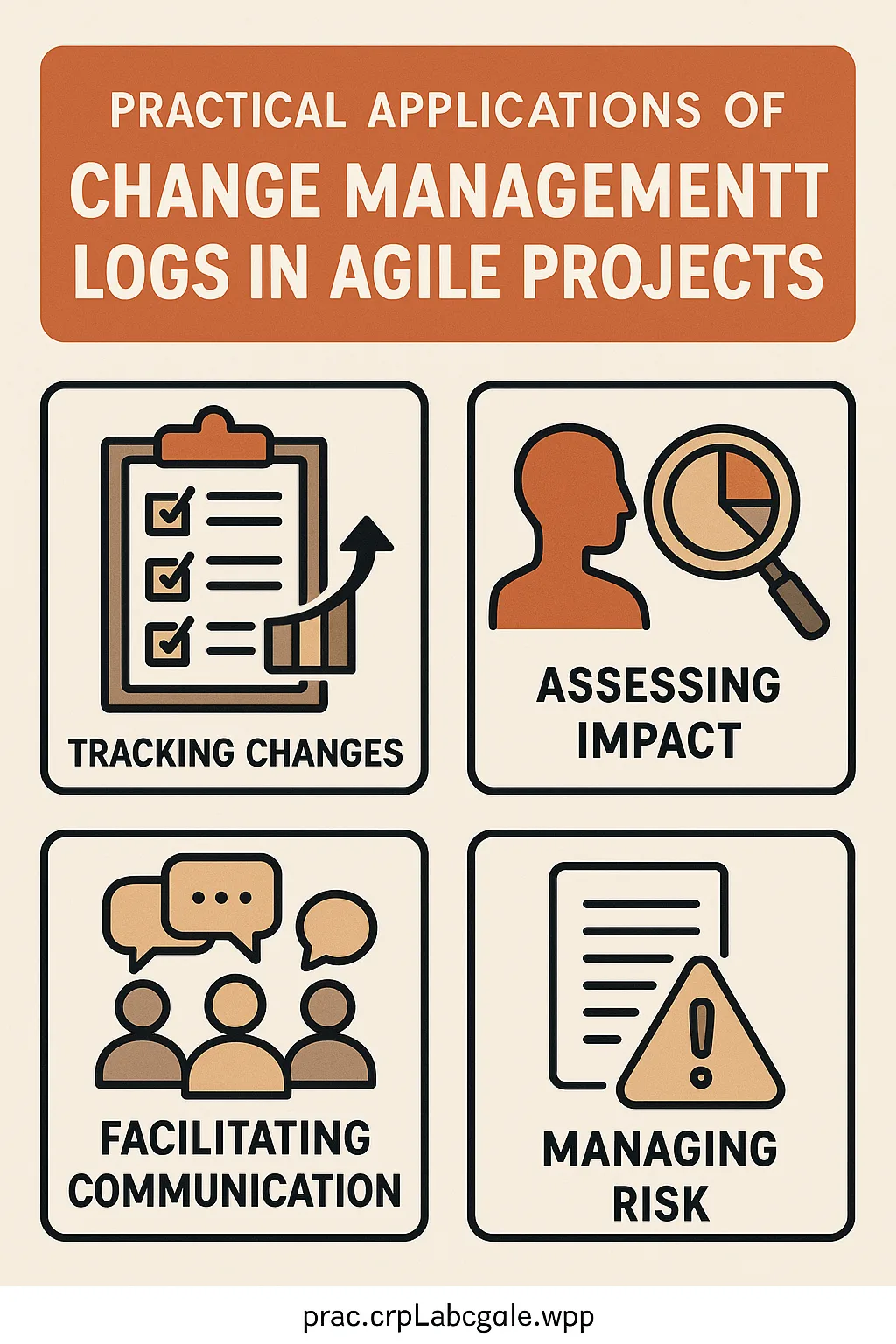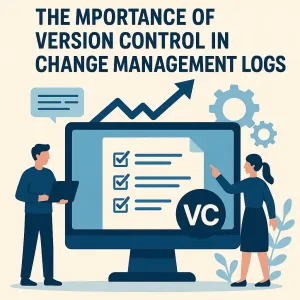Introduction to Change Management Logs
Particularly within Agile frameworks, change management logs serve as essential tools that facilitate the tracking and management of changes throughout the project lifecycle. These logs are systematic records that document alterations in project scope, requirements, and deliverables, ensuring that all team members are aligned and informed about the evolving nature of the project.
Definition and Role of Change Management Logs
Change management logs are structured documents that capture details about changes made during a project. They typically include information such as:
- Description of the Change: A clear explanation of what the change entails.
- Reason for the Change: The rationale behind the modification, which helps in understanding its necessity.
- Impact Assessment: An evaluation of how the change affects the project, including potential risks and benefits.
- Approval Status: Documentation of who approved the change and when, ensuring accountability.
In Agile project management, these logs play a crucial role in maintaining transparency and fostering communication among team members. They help Agile teams to keep track of modifications, ensuring that everyone is aware of the current project status and any adjustments that have been made.
Importance of Tracking Changes in Agile Environments
Agile methodologies emphasize flexibility and responsiveness to change, making the tracking of modifications vital. The dynamic nature of Agile projects often leads to frequent adjustments based on stakeholder feedback, market demands, or unforeseen challenges. By utilizing change management logs, Agile teams can:
- Enhance Communication: Keeping a detailed record of changes promotes open dialogue among team members, stakeholders, and clients, reducing misunderstandings and misalignments.
- Facilitate Decision-Making: With a comprehensive view of all changes, teams can make informed decisions quickly, adapting their strategies as needed.
- Improve Accountability: Change logs provide a clear trail of who made what changes and why, fostering a culture of responsibility within the team.
Alignment with Agile Principles of Adaptability and Responsiveness
The principles of Agile project management prioritize adaptability and responsiveness, which are inherently supported by the use of change management logs. These logs enable teams to:
- Respond to Evolving Requirements: As project needs shift, change logs allow teams to document and assess these changes systematically, ensuring that they can pivot effectively without losing sight of project goals.
- Iterate and Improve: Agile practices encourage continuous improvement, and change management logs provide the necessary data to reflect on past changes, learn from them, and refine processes for future iterations.
- Maintain Focus on Customer Value: By tracking changes that directly impact customer requirements, Agile teams can ensure that their adaptations align with delivering maximum value to stakeholders.
Change management logs are indispensable in Agile project management, providing a structured approach to documenting and managing changes. They enhance communication, support informed decision-making, and align with Agile principles, ultimately fostering a more adaptable and responsive project environment.
Benefits of Using Change Management Logs in Agile Projects
In the dynamic environment of Agile project management, maintaining a clear and organized change management log is essential for teams striving for adaptability and efficiency. Here are several key benefits of implementing change logs in Agile projects:
- Enhances Visibility of Changes: Change management logs provide a comprehensive record of all modifications made throughout the project lifecycle. This visibility allows team members to track what changes have been implemented, when they occurred, and the rationale behind them. Such transparency is crucial for maintaining alignment with project goals and ensuring that all team members are on the same page regarding the project’s evolution [5][10].
- Facilitates Better Communication: Effective communication is a cornerstone of Agile methodologies. Change logs serve as a central repository of information that can be easily accessed by all team members and stakeholders. By documenting changes, teams can ensure that everyone is informed about updates, which fosters collaboration and reduces the likelihood of misunderstandings or misalignments [7][12].
- Encourages Proactive Risk Management: By documenting potential impacts of changes, change management logs enable teams to identify and assess risks associated with modifications. This proactive approach allows Agile teams to anticipate challenges and develop strategies to mitigate them before they escalate, ultimately leading to smoother project execution and reduced disruptions [8][10].
- Supports Continuous Improvement: Agile practices emphasize the importance of learning and adapting. Change logs can be invaluable during retrospective meetings, where teams analyze what worked well and what didn’t. By reviewing documented changes, teams can identify patterns, assess the effectiveness of their responses to change, and implement improvements in their processes for future projects [6][14].
The implementation of change management logs in Agile projects not only enhances visibility and communication but also promotes proactive risk management and continuous improvement. These benefits collectively contribute to a more adaptable and resilient Agile team, better equipped to navigate the complexities of project management.
Best Practices for Creating and Maintaining Change Management Logs
Maintaining an effective change management log is crucial for enhancing adaptability and ensuring that all team members are aligned with the project’s evolution. Here are some best practices that Agile teams can adopt to create and maintain change logs effectively:
- Establish a Standardized Format: Consistency is key when it comes to change logs. By establishing a standardized format, teams can enhance readability and ensure that all entries are easily understood. This format should be adhered to across all changes to maintain clarity and organization [1].
- Include Essential Elements: Each entry in the change log should contain critical information to provide a comprehensive overview of the change. Essential elements to include are:
- Description: A clear and concise summary of the change being made.
- Date: The date when the change was implemented.
- Impact Assessment: An evaluation of how the change affects the project, including potential risks and benefits.
- Responsible Parties: Identification of team members or stakeholders responsible for the change [3][7].
- Promote Regular Updates and Reviews: Change logs should not be static documents. Agile teams should promote regular updates and reviews of the change log during sprint planning and retrospectives. This practice ensures that all team members are aware of recent changes and can discuss their implications, fostering a culture of transparency and continuous improvement [4][9].
- Utilize Collaborative Tools and Software: To enhance accessibility and collaboration, Agile teams should leverage collaborative tools and software for maintaining change logs. These tools can facilitate real-time updates and allow all team members to access the log easily, ensuring that everyone is on the same page regarding project changes [2][8].
By implementing these best practices, Agile teams can create and maintain effective change management logs that not only document changes but also support better adaptability and communication within the team. This proactive approach to change management can significantly enhance the overall success of Agile projects.
Integrating Change Logs into Agile Ceremonies
In Agile project management, the ability to adapt to change is paramount. One effective tool that Agile teams can leverage to enhance their adaptability is the change management log. This log serves as a record of all changes made throughout the project lifecycle, providing valuable insights that can be utilized during various Agile ceremonies. Here’s how Agile practitioners and Scrum Masters can effectively incorporate change logs into their ceremonies for maximum effectiveness.
Role of Change Logs in Sprint Planning Meetings
During sprint planning meetings, change logs play a crucial role in informing the team about previous modifications and their impacts on the project. By reviewing the change log, teams can:
- Identify Priorities: Understanding past changes helps the team prioritize tasks based on their relevance and urgency. This ensures that the most critical changes are addressed in the upcoming sprint.
- Set Realistic Goals: By analyzing the nature and frequency of changes, teams can set achievable goals for the sprint, taking into account the potential for further adjustments.
- Enhance Communication: Change logs facilitate discussions among team members about the rationale behind changes, fostering a shared understanding and alignment on project objectives.
Reviewing Change Logs During Daily Stand-Ups and Sprint Reviews
Daily stand-ups and sprint reviews are essential for maintaining momentum and ensuring transparency within the team. Incorporating change logs into these ceremonies can enhance their effectiveness:
- Daily Stand-Ups: Teams can briefly review the change log to discuss any new changes that may affect daily tasks. This allows team members to adjust their focus and collaborate more effectively on tasks that may have shifted in priority due to recent changes.
- Sprint Reviews: During sprint reviews, the change log serves as a reference point to evaluate the impact of changes on the deliverables. Teams can assess whether the changes led to improvements or if they introduced new challenges, providing a comprehensive view of the project’s evolution.
Reflecting on Change Logs During Sprint Retrospectives
Sprint retrospectives are a critical opportunity for teams to reflect on their processes and outcomes. Change logs can significantly enhance this reflection:
- Identifying Patterns: By analyzing the change log, teams can identify recurring themes or patterns in the changes made. This insight can help teams understand the underlying causes of frequent changes, whether they stem from unclear requirements, stakeholder feedback, or external factors.
- Lessons Learned: Reflecting on the change log allows teams to document lessons learned from past changes. This knowledge can inform future sprints, helping teams to anticipate potential challenges and improve their change management strategies.
- Continuous Improvement: The insights gained from reviewing change logs can drive continuous improvement initiatives, enabling teams to refine their processes and enhance their adaptability in future projects.
Integrating change management logs into Agile ceremonies not only enhances communication and collaboration among team members but also fosters a culture of continuous improvement. By effectively utilizing change logs, Agile teams can navigate the complexities of project management with greater agility and resilience.
Real-world Examples of Change Management Logs in Action
Change management logs are essential tools for Agile teams, enabling them to document, track, and manage changes throughout the project lifecycle. By effectively utilizing change logs, Agile practitioners can enhance adaptability, improve communication, and foster a culture of continuous improvement. Here are some success stories and insights from Agile teams that have successfully implemented change management logs.
Success Stories from Agile Teams
- Intel’s Scrum Odyssey:
- Context: Intel adopted Agile project management, specifically Scrum, to enhance project execution.
- Application of Change Logs: The team maintained a detailed change log that documented all modifications to project requirements and stakeholder feedback.
- Outcome: This practice allowed the team to quickly adapt to changing requirements, leading to improved stakeholder engagement and project outcomes. The change log served as a reference point for discussions during sprint reviews, ensuring that all team members were aligned on the current project status and any adjustments made [15].
- BBC’s Productivity Boost:
- Context: The BBC implemented Agile methodologies to enhance productivity across various projects.
- Application of Change Logs: The team utilized change logs to track changes in project scope and priorities, which were often influenced by audience feedback and market trends.
- Outcome: By documenting these changes, the BBC was able to pivot quickly in response to viewer preferences, ultimately leading to more relevant content and higher audience engagement. The change log facilitated transparency and accountability within the team, allowing for better decision-making [15].
Challenges Faced and Overcoming Them
- Resistance to Change: Many Agile teams encounter resistance from team members when changes are introduced. By maintaining a change log, teams can provide a clear rationale for changes, backed by documented feedback and data. This transparency helps in alleviating concerns and gaining buy-in from all stakeholders.
- Scope Creep: Agile projects often face challenges related to scope creep, where additional features or changes are requested beyond the original project scope. Change logs help teams track these requests, assess their impact, and prioritize them effectively. This structured approach ensures that the team remains focused on delivering the most valuable features while managing stakeholder expectations.
Tips Learned from Real-world Applications
- Regular Updates: Agile teams should update their change logs regularly, ideally during sprint reviews or retrospectives. This practice ensures that all team members are aware of the latest changes and can discuss their implications collectively.
- Involve the Whole Team: Encourage all team members to contribute to the change log. This inclusivity fosters a sense of ownership and accountability, making it easier to adapt to changes as a cohesive unit.
- Use Change Logs as a Learning Tool: Beyond tracking changes, teams can analyze their change logs to identify patterns and recurring issues. This analysis can inform future project planning and help teams anticipate challenges before they arise.
- Integrate with Other Agile Practices: Change logs should be integrated with other Agile practices, such as user stories and sprint planning. This integration ensures that changes are not only documented but also aligned with the overall project goals and objectives.
By leveraging change management logs effectively, Agile teams can enhance their adaptability, improve communication, and ultimately drive project success. These real-world examples illustrate the tangible benefits of maintaining a change log, providing valuable insights for Agile practitioners and Scrum Masters looking to optimize their project management processes.
Common Pitfalls and How to Avoid Them
Maintaining an effective change management log is crucial for ensuring adaptability and responsiveness to evolving project needs. However, Agile teams often encounter several common pitfalls that can hinder the effectiveness of their change logs. Here are some of the key issues and strategies to overcome them:
1. Inadequate Detail in Change Logs
One of the most significant mistakes Agile teams make is recording changes in a vague or insufficiently detailed manner. This lack of clarity can lead to misunderstandings and miscommunication among team members regarding the nature and impact of changes.
Solution:
– Encourage Comprehensive Documentation: Teams should be trained to document changes with sufficient detail, including the rationale behind each change, its expected impact, and any associated risks. This practice not only aids in clarity but also serves as a valuable reference for future decision-making.
2. Infrequent Updates
Another common issue is the infrequent updating of change logs. When changes are not logged promptly, it can create gaps in information, leading to confusion and a lack of accountability.
Solution:
– Establish Regular Review Cycles: Implement a routine for reviewing and updating change logs during team meetings or retrospectives. This ensures that all changes are captured in real-time and that the log remains a living document that reflects the current state of the project.
3. Lack of Team Engagement
A disengaged team can lead to poor management of change logs. If team members do not see the value in maintaining the log, they may neglect it, resulting in incomplete or inaccurate records.
Solution:
– Foster a Culture of Accountability: Encourage team members to take ownership of the change log by assigning specific roles or responsibilities related to its maintenance. Recognizing and rewarding contributions to the change log can also enhance engagement and motivation.
4. Insufficient Training and Onboarding
New team members may struggle with change log practices if they are not adequately trained during onboarding. This can lead to inconsistencies in how changes are documented and managed.
Solution:
– Implement Comprehensive Training Programs: Develop training sessions that cover the importance of change logs, best practices for documentation, and the tools used for managing them. Providing new team members with a mentor or buddy can also facilitate smoother integration into the team’s change management processes.
By addressing these common pitfalls, Agile teams can enhance their adaptability and responsiveness to change. A well-maintained change management log not only serves as a record of project evolution but also fosters a culture of transparency and collaboration within the team.
Conclusion: The Future of Change Management in Agile
The implementation of change management logs emerges as a pivotal practice that significantly enhances adaptability. These logs serve as a structured repository of changes, decisions, and their impacts, allowing Agile teams to maintain clarity and focus amidst the dynamic nature of their projects. By documenting changes systematically, teams can better understand the rationale behind each adjustment, facilitating informed decision-making and fostering a culture of transparency.
The value of change logs extends beyond mere documentation; they are instrumental in promoting continuous learning and improvement within Agile practices. As teams reflect on past changes and their outcomes, they can identify patterns, successes, and areas for enhancement. This iterative process not only strengthens the team’s ability to respond to future changes but also cultivates a mindset of resilience and adaptability, which is essential in Agile environments.
Moreover, the future of change management in Agile is not solely about adopting new tools or processes; it is about embracing a collaborative approach. By fostering an open dialogue within the Agile community, teams can collectively enhance their change management strategies, leading to more effective project outcomes.
The integration of change management logs into Agile practices is not just a trend but a necessity for teams aiming to thrive in a fast-paced environment. By recognizing their importance, committing to continuous improvement, and engaging with the broader community, Agile practitioners can ensure that they are well-equipped to navigate the complexities of change in their projects.
Find out more about Shaun Stoltz https://www.shaunstoltz.com/about/.
This post was written by an AI and reviewed/edited by a human.



